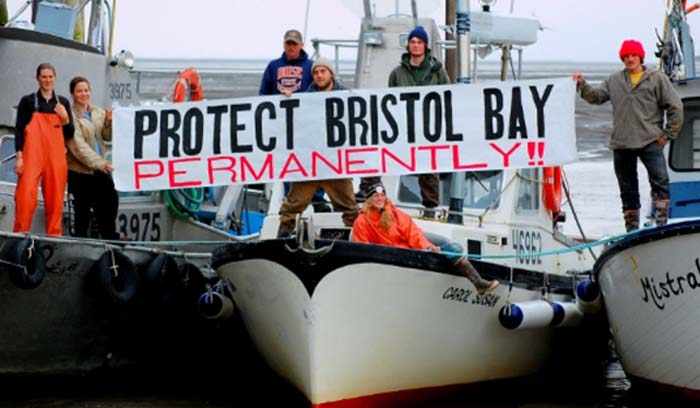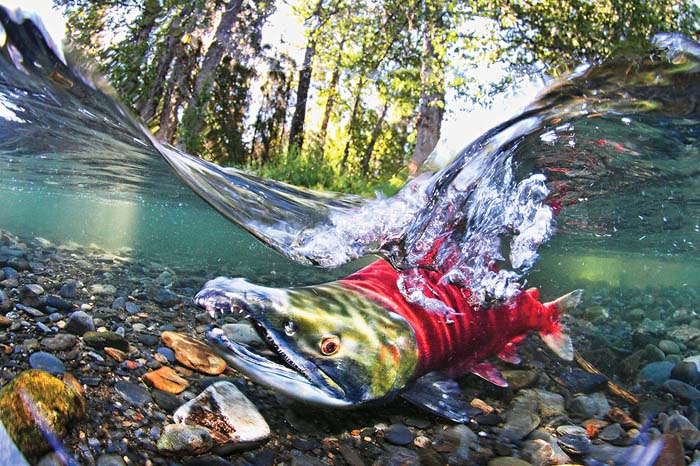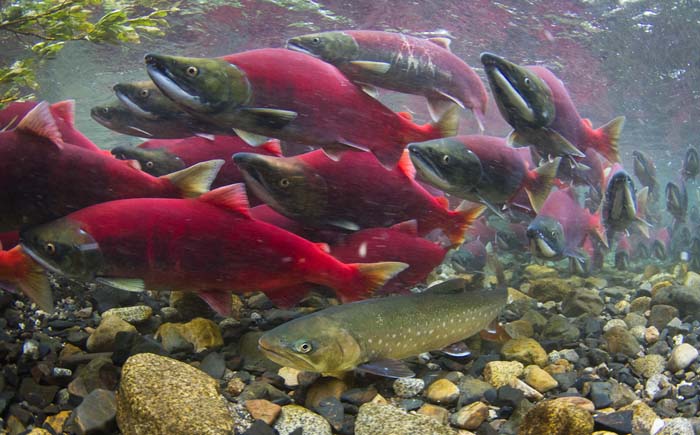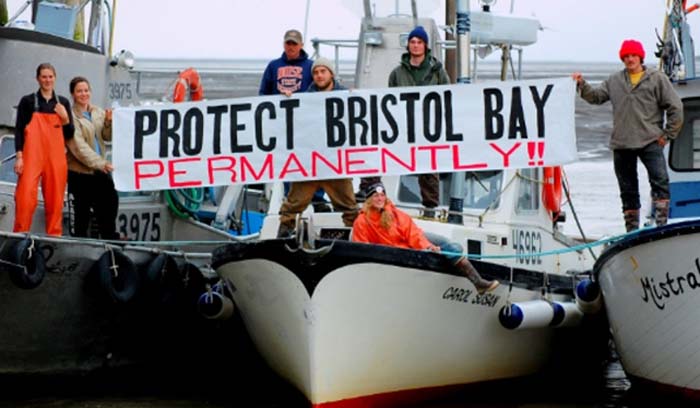
Regarding the destruction of Bristol Bay Watershed in Alaska, only foreign investors, curmudgeons, fools, current administration cabinet members and other paid off politicians are for the Pebble Mine. Photo: Luke Strickland / Alaska Marine Conservation Council — December 17, 2014.
The Pebble Mine saga enters a new chapter
The close of public comments is marked by familiar dividing lines, and surprising feedback from an EPA official.
By Liz Weber / High Country News / July 15, 2019
This story was originally published at High Country News.

Liz Weber is an editorial intern working in Washington, D.C., for High Country News and a student at American University.
[dropcap]R[/dropcap]oughly 62.3 million salmon beat their way upstream to the headwaters of southwest Alaska’s Bristol Bay in 2018. Their red, silvery bodies churned the water as they returned to the river of their ancestors in North America’s most productive salmon ecosystem. About 31% of the world’s wild sockeye harvest, which generates $1.5 billion annually and supports more than 10,000 U.S. jobs, depends on the watershed.
But the future of those salmon runs and the clean waters they depend on are complicated by a proposed copper and gold mine in Bristol Bay’s headwaters. The Pebble Mine, which was first proposed in the late 1980’s, is home to millions of tons of copper and gold. For three decades the mine has been a flashpoint for conservationists, Alaska communities and supporters of the development. With the process moving forward after the U.S. Army Corps of Engineers’ public comments closed on July 1, a decision on the Pebble Mine permit is expected in mid-2020.
During President Barack Obama’s administration, the proposal hit a significant roadblock in 2014 when the Environmental Protection Agency proposed restrictions under the Federal Clean Water Act that would limit the scope of the mine before a permit application was even filed. An environmental impact statement is required under the National Environmental Protection Act, and is often conducted by the federal agency with jurisdiction. In the case of Pebble Mine, both the EPA and the Army Corps are responsible for ensuring the project meets the requirements of the Clean Water Act.
The EPA and backers of the mine were in a stalemate until new life was breathed into the proposal this year. In June, the agency announced it was reconsidering the initial limitations
While President Donald Trump’s EPA was making moves to undo the 2014 limitations placed on a potential mining permit, the head of the EPA Region 10 office, which covers the Pacific Northwest and Alaska, Chris Hladick, unexpectedly took a different course. In July, he released a 100-page comment criticizing the Corps’ draft environmental impact statement. In the memo, Hladick argues the report lacked critical details and likely undervalued the risk of the proposed site to water quality. Hladick’s comments detailed the importance of the area to the Bristol Bay community, including the fishing industry.

The name “sockeye” is a corruption of an Indian tribes’ word “sukkai.” They average of 8-pounds and grow to 3-feet long. While spawning, the sockeye salmon is bright red with a greenish head. Later in their lives in the ocean, they turn to a silver with some blue and black on the head. Colors of the sockeye are very dependant on what stage of its life it is in. Life span is about five years. Sockeyes usually spend about one or two years in freshwater before migrating into the ocean. Adults usually stay in the ocean for two years and then go back to the freshwater to spawn. Wikipedia commons [Google Sites] image.
Opponents of the mine agree with Hladick that the Corps’ draft environmental impact statement was insufficient, and the company’s mining operation would contaminate the two rivers that drain into Bristol Bay, ultimately endangering the ecosystem and the migrating salmon that depend on it.
“We do not believe the impacts and risks to fish and fish habitat have been fully described, and we disagree with many conclusions reached based on the available data and ecological knowledge,” the Alaska chapter of the American Fisheries Society said in a statement.
Yet, the Pebble Partnership, the public relations arm for the proposed mine, said they are confident the Corps will address the concerns raised by the EPA. “The Corps has stated that in their view the project can be developed without harming the Bristol Bay fishery,” said Mike Heatwole, a spokesman with Pebble Partnership. “We stand by our work and will continue to work through this process,” he said.
Sen. Lisa Murkowski, R-Alaska, said she will review the comments made by the EPA, the scientific community and Alaskans. “I continue to reserve judgment about the Pebble Mine and am closely following the permitting process to determine whether it can avoid harming Bristol Bay’s world-class fishery,” she said in a statement.

Murkowski, who chairs the Senate Energy and Natural Resources Committee, also said she never supported the 2014 preemptive restrictions
“It is inappropriate for an agency to prejudge a project years before its developer has filed a permit application,” she said, adding that it would be a “dangerous precedent” to allow agencies to expand their authority in that manner.
But Bristol Bay is more than a political decision — it is the perfect environment for salmon, said Dan Cheyette, vice president of lands and natural resources with Bristol Bay Native Corporation (BBNC), one of thirteen Alaska Native Regional Corporations. BBNC has worked to educate the public on the permitting application process and the long-term impacts of a mine at the headwaters of Bristol Bay. In July, BBNC submitted more than 250 pages of comments on the Corps’ draft environmental impact statement.
According to Cheyette, it is not a matter of what would happen if the mine were to fail, but what the fallout looks like when the mine fails. “It’s not the place you can plop down a large open-pit mine,” he said. “It is putting at risk a fishery that feeds the world and has fed the people of Bristol Bay for thousands of years.”
Email High Country News or submit a letter to the editor.


